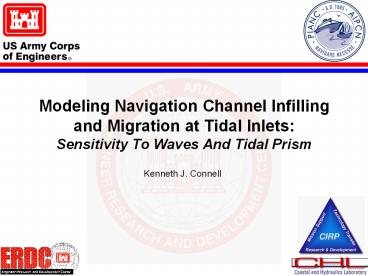Modeling Navigation Channel Infilling and Migration at Tidal Inlets: - PowerPoint PPT Presentation
1 / 33
Title:
Modeling Navigation Channel Infilling and Migration at Tidal Inlets:
Description:
Modeling Navigation Channel Infilling and Migration at Tidal Inlets: – PowerPoint PPT presentation
Number of Views:77
Avg rating:3.0/5.0
Title: Modeling Navigation Channel Infilling and Migration at Tidal Inlets:
1
Modeling Navigation Channel Infilling and
Migration at Tidal Inlets
- Sensitivity To Waves And Tidal Prism
Kenneth J. Connell
2
Morphologic Features of Navigable Tidal Inlets
Assateague Island
Ocean City Beaches
WA
Moriches Inlet, NY
Bypassing Path
Ocean City Inlet, MD
Mouth of the Columbia River
OR
3
Presentation Overview
- Discussion of Scope and Methods
- Presentation of some of the results obtained
- Concluding remarks and significance of findings
4
Scope and Methods
- Idealized simulations to examine 1st-order
effects - Varied channel-bar systems
- Sensitivity to wave forcing
- Sensitivity to tidal prism forcing
5
Coastal Modeling System (CMS)
- 2-D and 3-D Numerical modeling at local- to
regional-scale - coastal projects including
- Inlets
- Navigation channels
- Coastal structures
Matagorda Ship Channel, TX
Flood Current analysis of design alternatives
Mouth of the Columbia River
6
CMS Capabilities
- CMS model interconnectivity - all
- supported within the SMS interface
- CMS-M2D (w/explicit and implicit modes)
- CMS-WABED
- CMS-M3D
- STWAVE
- ADCIRC
- Efficient, high-resolution calculation of
- Hydrodynamic circulation water level
- Tide (including flooding drying)
- Waves
- Wind forcing
- Flow from river input
- Advection
- Storm surge and wave setup
- Sediment Transport
- Geomorphic evolution
- Salinity
7
Model Domain
8
Initial Channels
9
Waves
Wave Angle
30
10
Results
Bay
Barrier Island
Barrier Island
navigation channel infilling
Ocean
11
2 m Channel, Typical Waves
12
4 m Channel, Typical Waves
13
6 m Channel, Typical Waves
14
2 m Channel with Equilibrium Bar, Typical Waves
15
2 m Channel with Equilibrium Bar, Storm Waves
16
2 m Channel with Reduced Bay Area,Typical Waves
17
6 m Channel, No Waves(Tide Only)
18
(No Transcript)
19
Concluding Remarks
- Morphologic features systematically linked to
channel morphology - Storm condition bypassing occurs at greater
depths due to increased depth of closure under
the large wave regime - Numerical modeling of channel infilling,
migration, and sediment bypassing is becoming
more reliable
20
Acknowledgements
- PIANC USA
- John Paul Woodley, Jr. Chairman
- Major General Don T. Riley President
- Bruce Lambert Secretary
- Edmond J. Russo, Jr. Publications Chairman
- Coastal Inlets Research Program (CIRP)
- Nicholas C. Kraus Program Manager
- Jack Davis, Jim Clausner Technical Directors
21
Bay
Barrier Island
Barrier Island
Thank You!
navigation channel infilling
Ocean
22
(No Transcript)
23
(No Transcript)
24
(No Transcript)
25
(No Transcript)
26
(No Transcript)
27
Cohesive Transportin Navigation Channels
Hindered settling fluff layer
Important considerations in bays and sheltered
areas were fine material is source of channel
infilling
Matagorda Ship Channel, TX
28
2 m Channel with Equilibrium Bar, Shore Normal
Waves
29
2 m Channel with Equilibrium Bar, Shore Normal
Waves
30
6 m Channel with Equilibrium Bar, Typical Waves
31
6 m Channel, Storm Waves
32
6 m Channel with Equilibrium Bar, Storm Waves
33
2 m Channel, Storm Waves































